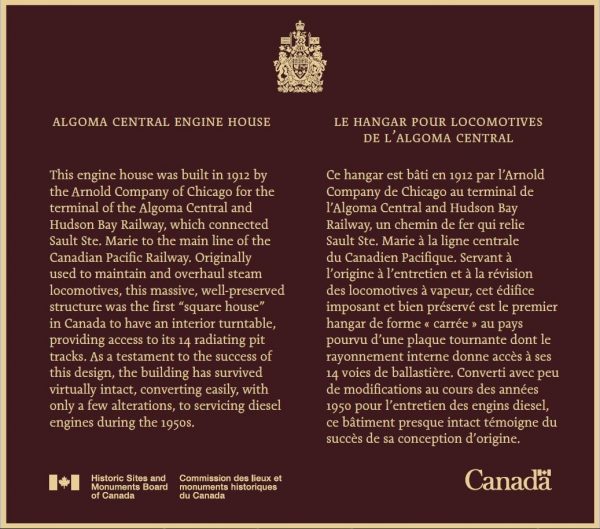
The Algoma Central Engine House was the first of only two engine sheds built to this design in Canada and is still in use today!
Representative of the early 20th century’s ambitions to increase and improve transportation through northern Ontario, the Algoma Central Engine House in Sault Ste. Marie, was the first train repair shed in Canada built with an internal turntable. Built in 1912, it has seen continuous use and is currently operated by CN.
Today, Dr. Richard Alway, Ontario Member of the Historic Sites and Monuments Board of Canada, commemorated the national historic significance of the Algoma Central Engine House on behalf of the Minister of Environment and Climate Change and Minister responsible for Parks Canada, Catherine McKenna. A plaque was unveiled during a ceremony at the CN Rail Yard in Sault Ste. Marie.
Built by the Algoma Central Railway to service steam trains, the Algoma Central Engine House was the first of only two engine sheds built to this design in Canada. Its massive size with a turntable built inside the building made it a unique design that has stood the test of time. Very few original elements of the building were changed when the building was modified to service diesel powered trains in the 1950s. Possessing massive windows, vitrified brick floor, high concrete foundation, steel roof columns and trusses and interior space for 14 locomotives, this building forms a direct connection to industrial development and expansion in Canada at the beginning of the 20th century.
“The Algoma Central Engine House highlights the importance of our community’s industrial heritage. As a structure that has been in continuous operation since 1912, this place connects generations of Saultites as a living link between the Victorian age and the 21st century. Historic designations provide an opportunity to connect with our diverse heritage.” Mr. Terry Sheehan, Member of Parliament for Sault Ste. Marie.
The Algoma Central Engine House, built to a massive scale, was the first such building in Canada to have an internal turntable. Today owned by CN, the success of its design is demonstrated by the building’s continued use, with many original features remaining intact.
The building has outlived the steam trains it was built to service. In the 1950s, with only a few alterations, the engine house began servicing diesel engines.
Created in 1919, the Historic Sites and Monuments Board of Canada advises the Minister of Environment and Climate Change regarding the national historic significance of places, people, and events that have marked Canada’s history.
About the Algoma Central Engine House
Representative of the early 20th century’s ambitions to increase and improve transportation through northern Ontario, the Algoma Central Engine House in Sault Ste. Marie, Ontario’s Steelton Yard, is a remarkably well-preserved example of its type. It was built in 1912 by the Arnold Company of Chicago for the terminal of the Algoma Central and Hudson Bay Railway, which connected Sault Ste. Marie to the Canadian Pacific Railway (CPR)’s main line. Originally used to maintain and overhaul steam locomotives, it was the first “square house” in Canada to have an interior turntable, providing access to its 14 radiating pit tracks. Its innovative design allowed the building to be easily converted, with only a few alterations, to servicing diesel engines during the 1950s.
The Algoma Central and Hudson Bay Railway was founded in 1899 by American-born industrialist Francis Hector Clergue. It initially connected Sault Ste. Marie to the massive iron deposits found near Michipicoten, Ontario, in 1897. Clergue’s empire collapsed in 1903. Following its acquisition by new ownership, the Railway connected with the CPR main line at Franz, Ontario. It was later renamed the Algoma Central Railway and became part of Canadian National’s Eastern Division in 2001.
With no precedent in Canada when it was built, the Algoma Central Engine House brought an innovative design to the country’s railroads. At the time, Canadian engine houses were typically smaller buildings that used a run-through design, where parallel tracks ran into, and often out the other side of the building. By comparison, the Algoma Central Engine House, with its interior turntable, was built to a massive scale. Its T-shape plan consists of a large engine house attached at right angles to a large machine shop. Double entry doors at opposite ends of the structure provide access. The design features a series of massive window openings along the engine house walls, set between the pilasters and anchored in brick, which help define the building’s aesthetic quality.
Since its construction, the Algoma Engine House has served the double purpose of performing both regular running repairs, typical of an engine house at a divisional point on a longer line, and major overhauls, which would normally be associated with a repair shop, not an engine house. It was a magnificent success, not only in its original intended purpose of servicing steam locomotives, but also in converting to diesel maintenance in the 1950s with limited alterations. In Canada, this is unique to the Algoma Engine House. As a testament to the success of its design, the building has survived virtually intact.
- Batchewana FN & Alamos Gold Begin Next Phase of the Mine Connector Transmission Project - December 16, 2025
- Mixed Curling Standings – December 13 - December 13, 2025
- Ladies Curling Standings – December 12th - December 12, 2025
 Wawa-news.com You can't hear the 'big picture'!
Wawa-news.com You can't hear the 'big picture'!